Eggs Rolls: 15 Facts About The Popular Chinese Food
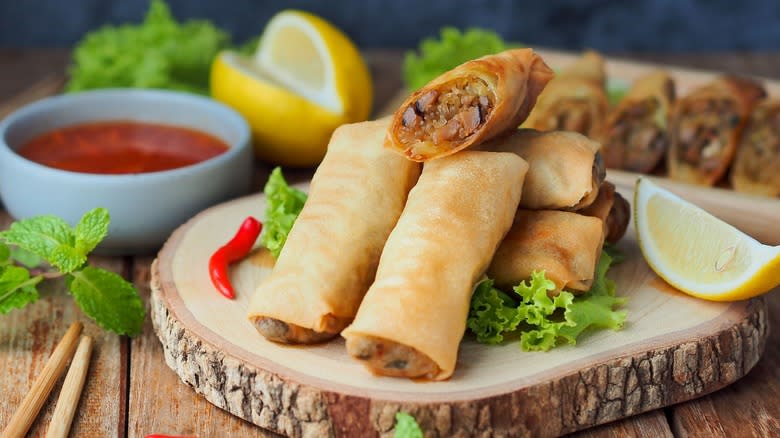
Chinese-American egg rolls are amongst some of the most popular dishes that you can order at a Chinese restaurant or takeout. Crispy, salty, hot, and delicious, they come with a range of different fillings and are so moreish that eating just one is almost impossible.
Chances are, you're usually too busy tucking into your egg rolls — and other tasty Chinese dishes — to pay too much thought to where egg rolls come from. However, exploring the fascinating history and flavors of this popular Chinese food can be quite rewarding.
From its origins to the difference between spring rolls and egg rolls and what fillings you'll typically find in them to how they're made, there's plenty to discover about this yummy appetizer or dim sum dish. We've rounded up 15 facts about egg rolls — some of them you may already know and have heard before, and some of them may surprise you.
Read more: 11 Of The Best Cooking Tips From Bobby Flay
The Egg Roll's Origins Are Unclear
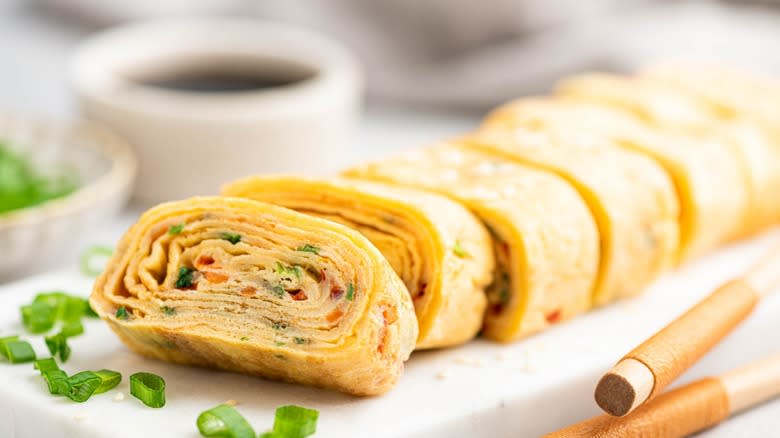
To this day, we don't really know who created egg rolls. Some stories say it was New York chef Lung Fong who invented the delicacy back in 1925. Others credit chef Henry Low of the restaurant Port Arthur in New York City. However, Low's recipe, published in his book Cook At Home In Chinese in 1928, apparently didn't contain cabbage, a key ingredient of the egg roll we know and love today.
Prior to this, there was mention of a dish called dan gun, or egg roll, in 1917 in a Chinese recipe book. This dish bore even less resemblance to today's egg rolls and was instead a variety of fillings wrapped in an omelet, not dissimilar to the South Korean dish gyeran-mari.
Though most people consider egg rolls an American-Chinese invention rather than a typical Chinese dish, this might not be the case. Some claim that egg rolls have their roots in ancient China and are, in fact, a relative of the spring roll with a denser wrapper.
Egg Rolls Are High In Calories, Saturated Fat, And Sodium
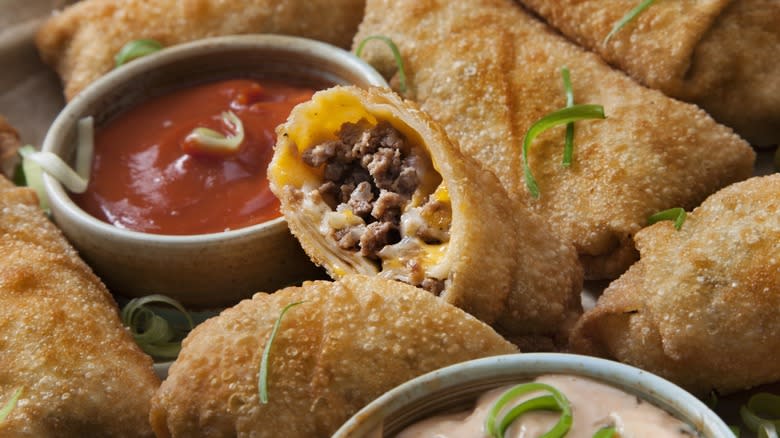
Egg rolls might be absolutely delicious, but sadly, like most foods that taste amazing, they're not the healthiest choice to consume on a regular basis, according to Healthline. They are usually deep-fried, so they're high in saturated fat and calories. The average egg roll contains between 200 and 250 calories and 10 to 15 grams of fat. That's for one egg roll; stopping at just one can be difficult.
While it's true that they are filled with vitamin and mineral-rich vegetables and often meat, they're also pretty high in sodium. There's around 417mg of sodium in a single roll. That's 18% of the recommended daily allowance. They are usually served with a dip such as hoisin, sweet chili sauce, plum sauce, or similar, which adds even more sodium to the mix.
We're not saying you shouldn't eat them; just be mindful of the fact that they are high in fat, calories, and salt. Consuming them as a treat when you enjoy your favorite Chinese takeout is usually fine in moderation.
Egg Rolls Can Have Various Different Fillings
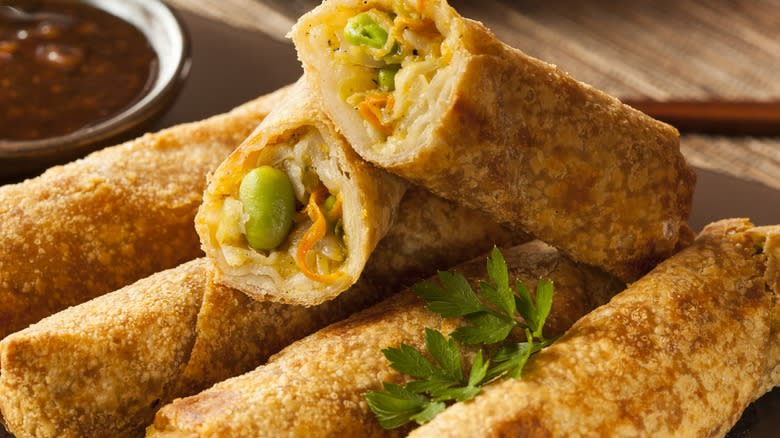
What's inside an egg roll? That depends on where you order your egg rolls, as they can contain various fillings. Most egg rolls contain some kind of meat. Ground or roast pork is typically used, but you will also find egg rolls filled with duck, chicken, beef, or shrimp. They also contain various vegetables, such as shredded carrots, scallions, celery, and cabbage.
Some egg rolls only contain vegetables, or vegetables and tofu, but they consistently have garlic and ginger in the filling for added flavor. Beansprouts are another common addition, but it's not mandatory. However, you won't ever find noodles or bamboo shoots in traditional egg rolls.
If you're making your own egg rolls at home, you can add almost any vegetable you like. It can go in your egg roll if it can be shredded or cut into small pieces. It's important to note that egg roll fillings are different from the fillings found in spring rolls, too.
Spring Rolls Are Different From Egg Rolls
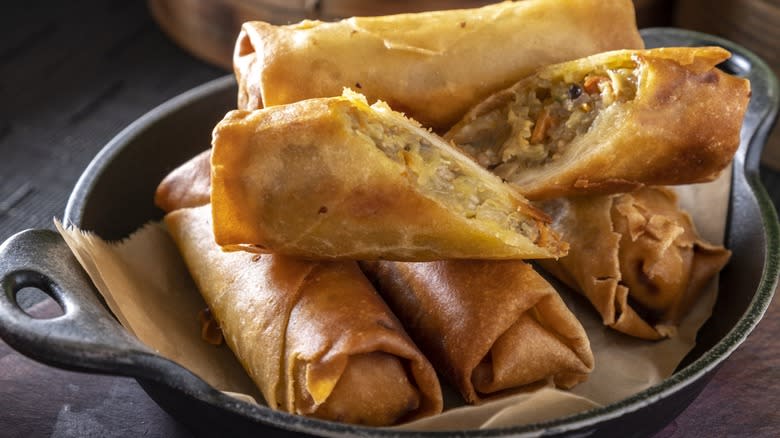
It's easy to confuse egg rolls and spring rolls. They're both Chinese appetizers or dim sum, they're both roll-shaped, and both are absolutely delicious. However, there are some key differences between the two.
Spring rolls have their roots in Cantonese cuisine, and you'll find them on offer as an appetizer in Cantonese restaurants or on the menu in many dim sum establishments. You can bake, fry, or deep-fry your spring rolls. Spring rolls typically contain ground meat usually pork, cabbage, and carrots, as well as bamboo shoots and shiitake mushrooms. Egg rolls are generally deep-fried, unlike their Cantonese cousins.
Finally, the wrappers for the two rolls may be the easiest way to tell them apart. Egg rolls often have a thicker wrapper that has a bumpy, rough appearance when deep-fried. Spring rolls don't have eggs in their wrappers, so they are usually smooth.
Egg Rolls Don't Have To Contain Egg
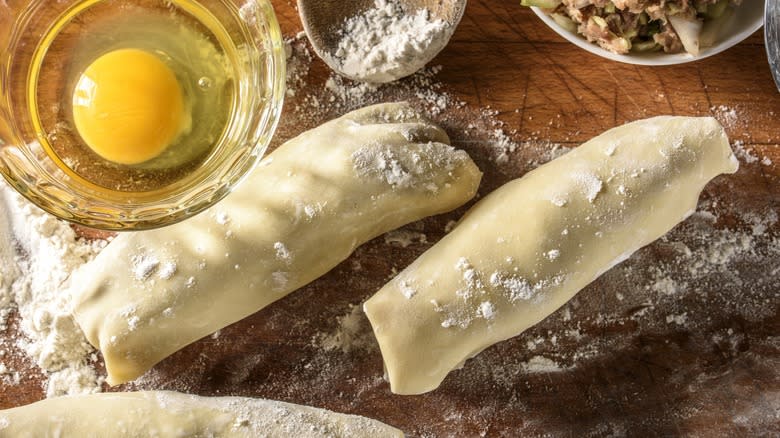
Egg rolls have evolved over time, and their name can be misleading. The Wrappers for these treats often don't have any eggs in them at all. The reason for the confusing name is that the egg roll may come from the aforementioned recipe published in 1917 for dan gun. Unlike the egg rolls we love today, this dish was made with a variety of fillings such as meat and beansprouts rolled up into a cylindrical omelet.
So don't be confused by the name egg roll if you can't eat eggs or you're following a vegan diet. If the menu has a tofu or veggie option it might be a safe bet to add them to the order. Of course, make sure to check with the restaurant that they don't contain eggs, but you may find you're able to enjoy them after all.
National Egg Roll Day Is On June 10
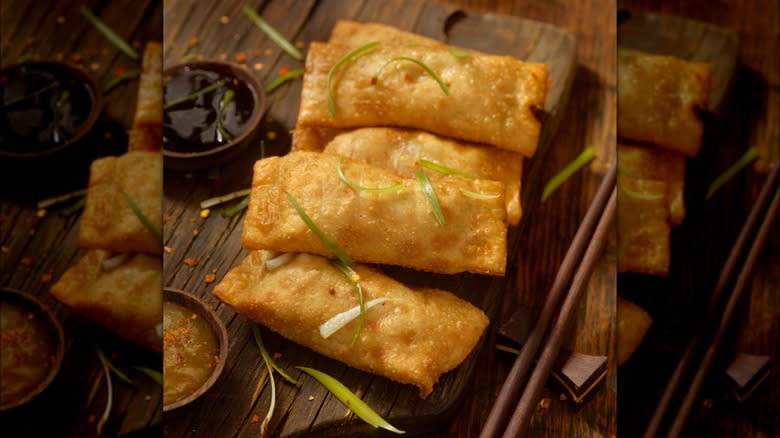
Egg rolls are a beloved food, and they even have their own day. June 10 is National Egg Roll Day, so if you ever need an excuse to eat egg rolls, this is the day to do it. National Egg Roll Day hasn't been around all that long — it only started in 2019 and is celebrated to honor Van and Kim Nguyen, founders of Van's Kitchen restaurant in Dallas, Texas.
The restaurant is actually Vietnamese, and the family became renowned for its delicious egg rolls. Van's Kitchen uses delicious fresh ingredients and crafts all its authentic egg rolls from scratch.
However, you don't have to head to Dallas to celebrate National Egg Roll Day. You can enjoy authentic egg rolls from your local Chinese takeout or restaurant. You may even find some places have special deals available on June 10 to celebrate the holiday.
Other Countries Have Their Own Takes On Egg Rolls
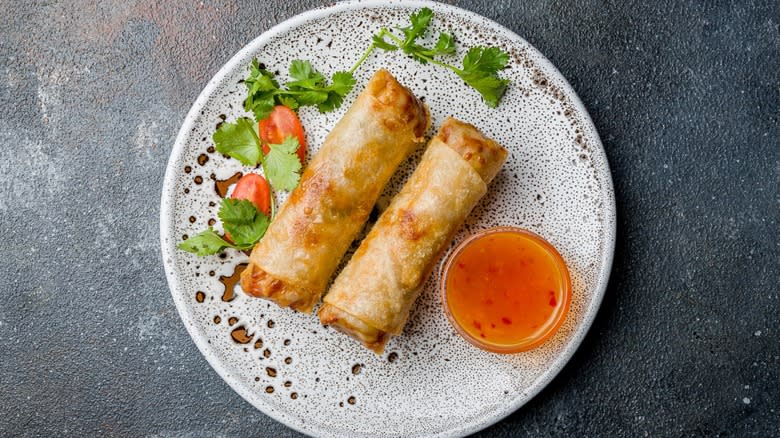
Though most egg rolls are Chinese-American, other countries have come up with their own takes on the classic egg roll. Head for Vietnam, and you'll find chả giò. Like egg rolls, chả giò has bumpy wrappers, usually made from rice paper, and they are traditionally deep-fried. The most common meat for the filling is ground pork, with mung bean thread noodles, mushrooms, and vegetables. They're often served with nước chấm, a dipping sauce made with fish sauce, shredded carrots, chili, lime juice, sugar, garlic, and vinegar.
South Korea's take on egg rolls is Gyeran-mari, which literally means egg roll. This actually bears little resemblance to modern-day egg rolls and has more in common with dan gun. It's a rolled omelet that's usually served as a side dish. Gyeran-mari usually contains carrots and scallions, but beyond this, you can add almost any fillings you can think of. The key is to dice the fillings finely so they mix with the egg.
In the Philippines, lumpia is a popular food served at special dinners. A wheat pastry wrapper is filled with vegetables and ground pork before being fried. Thailand has popiah, crispy rolls filled with Chinese sausage, eggs, tofu, cucumber, scallions, and beansprouts. These rolls often have a topping of crab and a sweet-sour tamarind sauce.
Egg Rolls Are Usually Deep-Fried
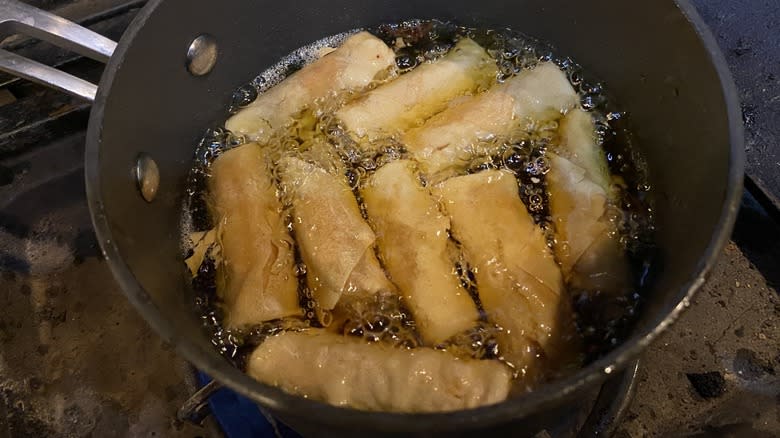
Earlier, we mentioned that egg rolls are typically deep-fried. This makes them high in fat, particularly saturated fat. Note, though, that the fat content will depend on the type of oil used for deep frying.
If you're eating egg rolls from a Chinese takeout or dim sum restaurant, corn or peanut oil will typically be used for deep-frying, as these oils can reach a high temperature before burning. For preparing deep-fried egg rolls at home, many home chefs typically use the cheapest oil they can find, such as vegetable oil. However, this may not be the best option.
Because cheap vegetable oil breaks down at high heat — needed for deep-frying — and can also become infused with odors from whatever you're cooking, it will need to be replaced often. This means it's likely more cost-effective to use peanut or corn oil.
By shopping around, you can often find large bottles of these types of oil at Asian grocery stores for a more affordable price than your regular grocery store. It's worth noting that you don't have to deep-fry egg rolls.
You Can Make Egg Rolls At Home For A Healthier Alternative
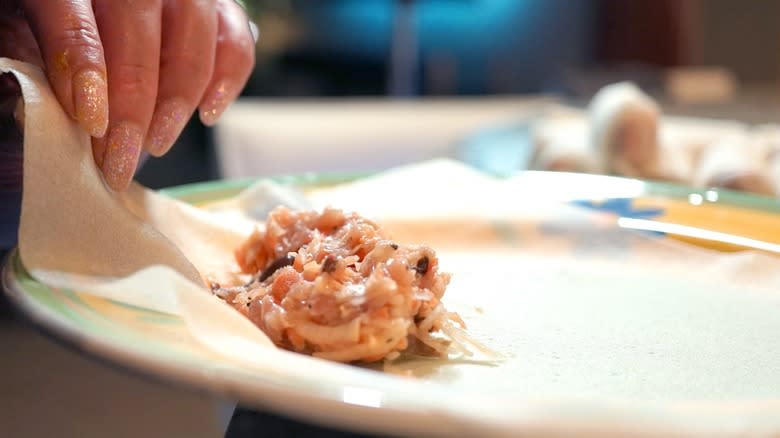
Whether you are trying to save money by making your own egg rolls or simply looking for a healthier alternative to the deep-fried egg rolls from your local Chinese takeout, it's relatively easy to prepare your own egg rolls at home.
Deep frying can be messy, with splashing oil, and it can also be dangerous, particularly if you have small children at home. You don't need to deep-fry egg rolls, though. You can cook egg rolls in your air fryer if you have one. Don't have an air fryer? Just bake them in a hot oven until the wrappers are crispy.
Not only is this less messy, but it also cuts back on saturated fat and calories. Air frying or baking egg rolls ensures they're a healthier choice, as noted on Healthline, so you can enjoy them more often.
It's Traditional To Dip Egg Rolls In Sauce
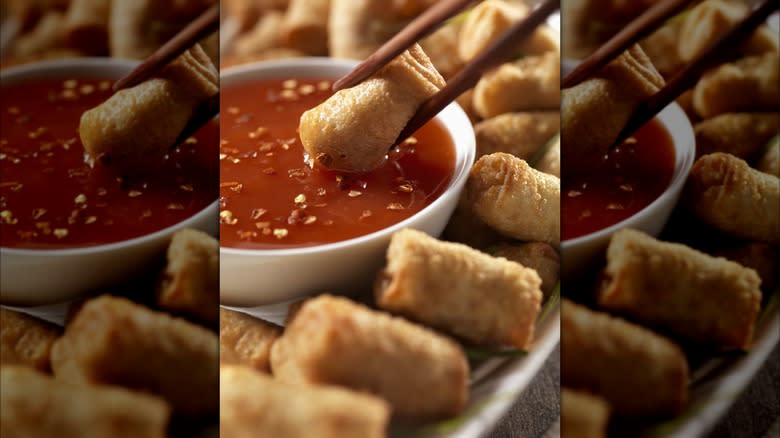
Whenever egg rolls are on the menu, you can almost guarantee dipping sauce will also be involved. But what sauce is typically served with egg rolls? If you're eating authentic egg rolls at a Chinese restaurant, you'll often find plum sauce or sweet and sour sauce served for dipping. Peanut sauce or hoisin sauce are two other popular choices, and some restaurants even serve spicier sauces such as sriracha.
Making egg rolls at home? You can whip up almost any sauce you like for your appetizers. Gyoza or dumpling dipping sauce can be made with soy, sesame oil, rice vinegar, and chili flakes. You can also make a simple garlic honey soy sauce, or if you're feeling adventurous, you can whip up any kind of dipping sauce of your own and give it a try, it might not be authentic but it can be just as delicious.
Egg Rolls Don't Usually Contain Shitake Mushrooms Or Bamboo Shoots
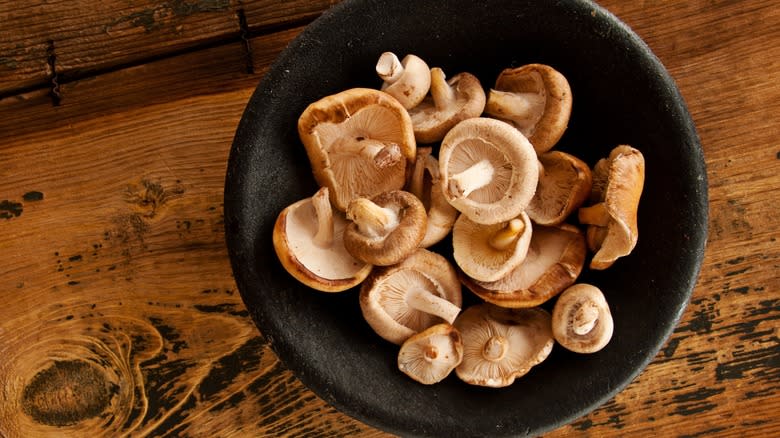
One of the key differences between egg rolls and spring rolls is in the fillings. As we mentioned, traditional egg rolls don't contain bamboo shoots or shiitake mushrooms. That's not to say you can't add these ingredients to your homemade egg rolls if the notion takes you. It's just that authentic egg rolls that are made in Chinese restaurants likely won't contain these two ingredients.
Egg rolls typically replace these two ingredients with scallions and celery, but if you're making your own egg rolls, feel free to add any fillings you like. Remember that fillings that leach a lot of moisture, such as mushrooms, may make your egg rolls soggy or less crispy if you accidentally add too much. It should also be noted that bamboo shoots of the canned variety may contain extra water in them. Drain and pat dry before adding them to the mix to ensure that you don't add more unnecessary moisture to your eggrolls.
Egg Rolls Can Be A Good Source Of Dietary Fibre And Protein
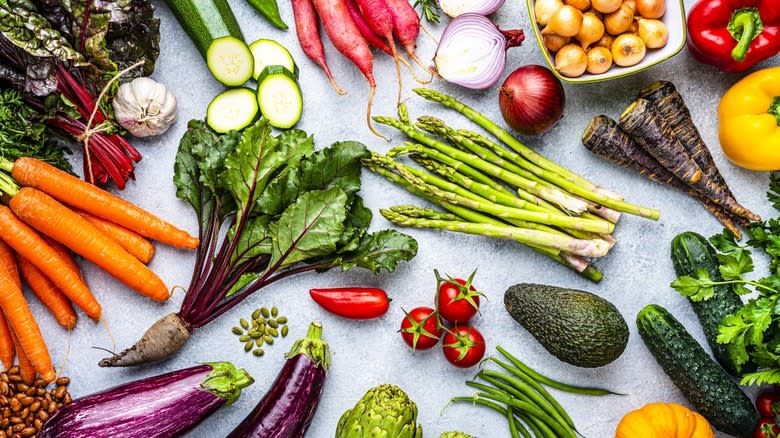
Egg rolls can be a good source of dietary fiber because they're usually packed with veggies. Chinese restaurants and takeouts typically make them with shredded carrots, scallions, cabbage, and celery. Depending on the restaurant, they might contain other veggies, too. If you make your own, you can add whatever vegetables you like.
A typical egg roll provides around 2.3 grams of fiber, which is 8% of the Daily Value of fiber. It's recommended to consume between 25 and 38 grams of fiber a day to promote regular bowel movements and feelings of satiety. According to Dietary Guidelines for Americans, fiber can also help to reduce your risk of heart disease and colorectal cancer.
Along with being high in fiber, egg rolls are also packed with protein. This is from the meat included in most egg rolls, and egg rolls that contain egg in the wrapper will be even higher in protein.
A typical egg roll contains around 14% of the Daily Value of protein recommended. Protein is important to ensure healthy bones and muscles and for tissue repair and growth, according to the British Nutrition Foundation.
You Can Make Egg Rolls With Raw Or Pre-Cooked Fillings
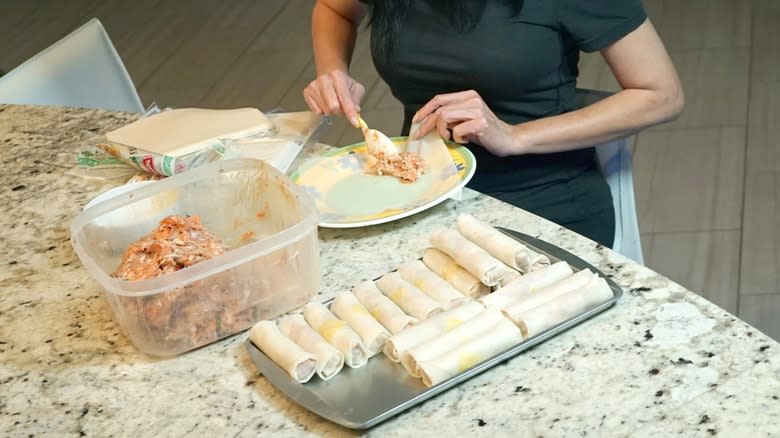
Some people swear by using raw fillings in their egg rolls. Others prefer using cooked ingredients. There's really no right or wrong here, but pre-cooking the filling for your egg roll results in a deeper flavor, as everything has time to come together and brown in a pan. This also means that juices from the ingredients will be released in the pan and cooked down, so the finished egg roll will be crunchy, crisp, and fairly dry. This might be your best bet if you're using ingredients that release a lot of water, such as mushrooms.
However, if you prefer your egg rolls on the juicier side, you should use raw filling. Adding raw fillings to your wrapper will allow them to release juices as the egg roll fries or bakes. This results in a juicy and moist finished result, however too much will cause it to become soggy.
Most Egg Roll Recipes Use Ginger And Garlic
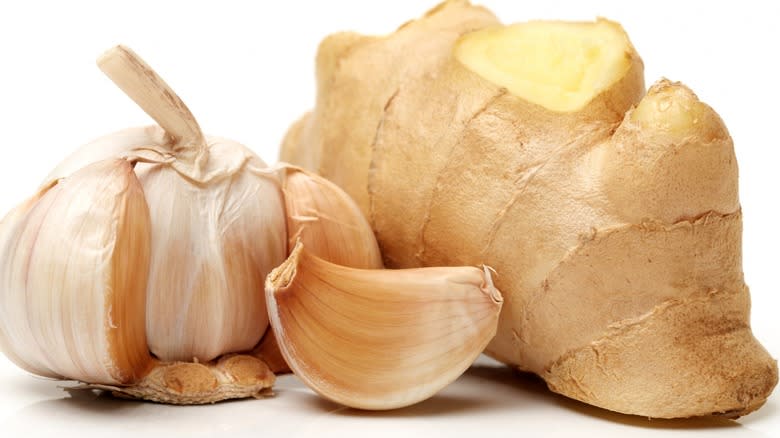
Every egg roll needs two key ingredients aside from the wrapper. Ginger and garlic are key to creating a delicious filling for your egg roll. Garlic and ginger are a staple base for most Chinese dishes, and they add loads of flavor to the egg roll filling.
You should use fresh ginger and garlic when making egg rolls at home. However, if you don't have any to hand, you could always use jarred or even pre-prepared ginger and garlic to ensure you are not missing out on that delicious flavor.
If you don't like the taste of either of these ingredients, you can skip one or both of them when making egg rolls at home. They're essential ingredients if you want to achieve that authentic, multi-layered flavor that Chinese cuisine is known for, though, so we recommend giving them a try before excluding them outright.
Egg Rolls Don't Contain Noodles
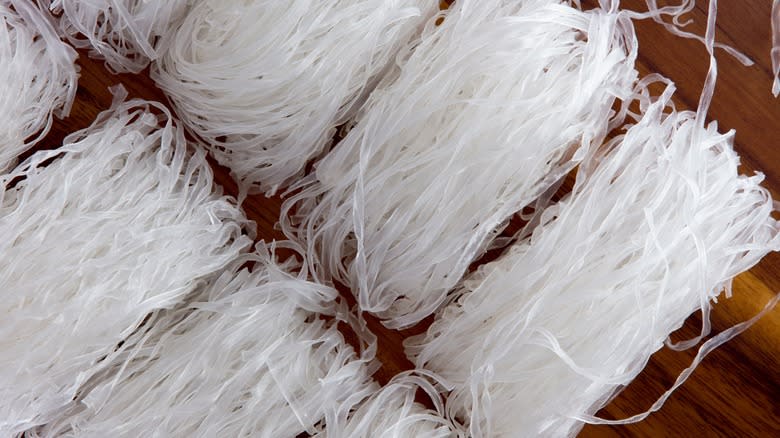
You might be tempted to add some noodles to your egg rolls. After all, noodles are found in many Chinese dishes, and egg rolls are a Chinese appetizer. However, as we mentioned, traditional egg rolls from a Chinese restaurant won't be filled with noodles. They often contain beansprouts but never noodles.
However, if you're eating Vietnamese egg rolls, known as chả giò, then these often do contain noodles. Bean thread noodles, also known as cellophane or glass noodles, are the usual type included in chả giò. Vietnamese summer rolls — uncooked cold rice paper rolls usually filled with shrimp or pork, lettuce, herbs, carrots, and cucumber — generally contain bean thread noodles.
If you're really craving noodles, you could always order a side of chow mein or pork lo mein alongside your egg rolls. But you can certainly try adding them to your homemade version and create your own take on the classic dish.
Read the original article on Daily Meal.

